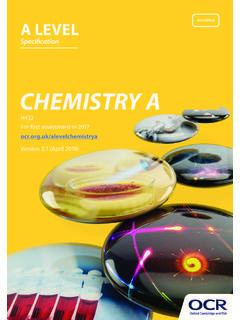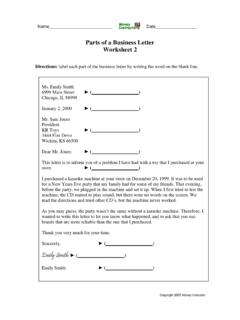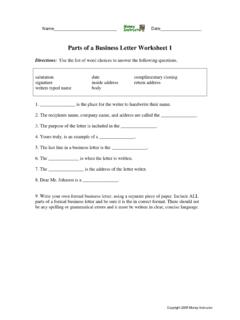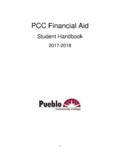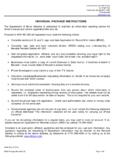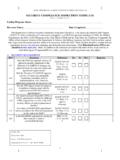Transcription of Advanced Subsidiary GCE Unit F212: Molecules, …
1 GCE. Biology Advanced Subsidiary GCE. unit f212 : molecules , biodiversity , food and health Mark Scheme for January 2012. Oxford Cambridge and RSA Examinations OCR (Oxford Cambridge and RSA) is a leading UK awarding body, providing a wide range of qualifications to meet the needs of candidates of all ages and abilities. OCR qualifications include AS/A Levels, Diplomas, GCSEs, OCR Nationals, Functional Skills, Key Skills, Entry Level qualifications, NVQs and vocational qualifications in areas such as IT, business, languages, teaching/training, administration and secretarial skills. It is also responsible for developing new specifications to meet national requirements and the needs of students and teachers.
2 OCR is a not-for-profit organisation; any surplus made is invested back into the establishment to help towards the development of qualifications and support, which keep pace with the changing needs of today's society. This mark scheme is published as an aid to teachers and students, to indicate the requirements of the examination. It shows the basis on which marks were awarded by examiners. It does not indicate the details of the discussions which took place at an examiners' meeting before marking commenced. All examiners are instructed that alternative correct answers and unexpected approaches in candidates' scripts must be given marks that fairly reflect the relevant knowledge and skills demonstrated.
3 Mark schemes should be read in conjunction with the published question papers and the report on the examination. OCR will not enter into any discussion or correspondence in connection with this mark scheme. OCR 2012. Any enquiries about publications should be addressed to: OCR Publications PO Box 5050. Annesley NOTTINGHAM. NG15 0DL. Telephone: 0870 770 6622. Facsimile: 01223 552610. E-mail: f212 Mark Scheme January 2012. Annotations Annotation Meaning Correct answer Incorrect response Benefit of Doubt Not Benefit of Doubt Error Carried Forward Given mark Underline (for ambiguous/contradictory wording). Omission mark Ignore Correct response (for a QWC question).
4 QWC* mark awarded 1. f212 Mark Scheme January 2012. Question Answer Marks Guidance 1 (a) (i) N; 1 IGNORE nitrogen DO NOT CREDIT n or N2. 1 (a) (ii) 1 Mark the first answer. If the answer is correct and an additional answer is given that is incorrect or contradicts the correct answer then = 0 marks polypeptide / protein ; IGNORE peptide 1 (a) (iii) 3 max Maximum two marks for description. Name must be given to award 3 marks. ACCEPT marking points from diagram where amine and carboxyl groups are clearly labelled. Mark writing first then look at diagram. If diagram contradicts creditable text award maximum one mark for description. name DO NOT CREDIT dipeptide peptide (bond / link).
5 Plus any two from .. ACCEPT phonetic spellings of amine and carboxyl description of formation ACCEPT carboxylic acid' and amino'. DO NOT CREDIT amide / carbonyl between, amine group (of one amino acid). and carboxyl group (of another) ;. H (from amine) combines with OH (from carboxyl) ;. condensation (reaction). OR. water, lost / eliminated / produced / created / AW ;. 2. f212 Mark Scheme January 2012. Question Answer Marks Guidance 1 (b) (i) 8 max Annotate property (number 1) marks with 1 symbol to help distinguish marks for QWC. All marks are stand alone V1 high latent heat of vaporisation / large amount of energy V1 ACCEPT large amount of heat needed.
6 Required to change from liquid to gas / AW ;. V1 ACCEPT high latent heat of evaporation'. V2 evaporation is (efficient) cooling mechanism / AW ; V2 ACCEPT evaporation removes heat from body'. V3 example of cooling in living organism ; V3 sweating, panting, transpiration (as cooling). high latent heat of evaporation means sweat cools you down' = 3 marks H1 high specific heat capacity / large amount of energy needed H1 ACCEPT water / it, is thermally stable'. to, raise / change, temperature ;. H1 ACCEPT water is slow to change temperature'. H1 CREDIT the temperature of the sea does not change much'. H2 (thermally) stable environment for, aquatic / H2 thermally' can be inferred from previous statement named aquatic, organisms.
7 H3 (aquatic) organisms use less energy on temperature control ;. H4 (internal) temperature of organisms changes only slowly ;. H5 (biological) reactions / enzymes / metabolism, function(s) H5 IGNORE organisms function correctly'. correctly ;. F1 ice, is less dense than water / floats ; F1 ACCEPT maximum density is at 4 C'. F2 (surface of) ice provides habitat for, organisms / named F2 polar bears on ice'. organism ;. 3. f212 Mark Scheme January 2012. Question Answer Marks Guidance I1 water (beneath ice), insulated / remains liquid / doesn't freeze ;. I2 (aquatic) organisms, do not freeze / can still swim ; I2 IGNORE unqualified references to survival I2 ACCEPT gametes / AW, can be dispersed S1 (effective) solvent.
8 S2 medium for reactions / (internal) transport medium / able to dilute toxic substances ;. C1 cohesion / adhesion ;. C2 example of cohesion / adhesion, in living organism ; C2 transpiration stream / apoplast movement C2 ACCEPT descriptions T1 surface tension ;. T2 habitat for (named) invertebrates ; T2 ACCEPT insects IGNORE animals P1 transparent ;. P2 allows underwater photosynthesis ; P2 ACCEPT other example of transparency linked to survival, eyes D1 idea of high density ; D1 IGNORE references to viscosity D2 allows flotation / support ;. U organisms can still obtain, oxygen / (named) minerals / food / U not linked to a single property and so cannot contribute carbon dioxide, from water ; to QWC.
9 U IGNORE nutrients / nutrition 4. f212 Mark Scheme January 2012. Question Answer Marks Guidance QWC: a property mark (with number 1) and a survival mark 1 H1 and H3 and S1 and S2. with the same letter seen twice. 5. f212 Mark Scheme January 2012. Question Answer Marks Guidance 1 (b) (ii) 3 max Mark the first answer on each prompt line. 1 protein secondary structure / -helix / -pleated sheet ;. 2 (protein) tertiary structure ;. 3 between polypeptide chains in (named) quaternary 3 between adjacent chains in collagen structure ;. CREDIT protein / named protein / enzyme' OR. between amino acid R-groups' once ONLY if none of mps 1-3 have been awarded 4 (between chains of) cellulose ; 4 IGNORE macrofibrils 5 (between, strands of / bases in) DNA.
10 6 AVP ; ; ; 6 between mRNA and tRNA. binding between enzyme and substrate (coiling of) amylose between DNA and mRNA during transcription Total 17. 6. f212 Mark Scheme January 2012. Question Answer Marks Guidance 2 (a) 2 max Mark the first answer on each prompt line. ACCEPT ora throughout 1 nucleus / nuclei ; 1 ACCEPT DNA not free'. 2 other named organelle / 2 mitochondria / Golgi / etc membrane bound organelles ; 2 ACCEPT compartmentalized organelles 2 ACCEPT don't have a mesosome 3 linear chromosomes ;. 4 DNA, associated with / AW, histones / protein ; 4 ACCEPT DNA not naked'. 5 80S / 22nm / large, ribosomes ;. 6 large cells / AW ;. 7 no cell wall.









